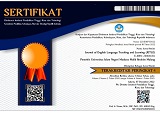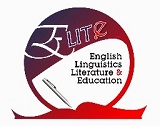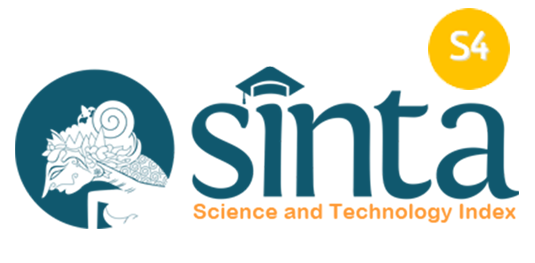Mapping Vocabulary: A corpus-based comparison of Indonesian fourth-grade students' writing and English language textbooks
Abstract
This study compares the vocabulary used by Indonesian fourth-grade students in their free writing with that taught in their English language textbooks to assist language teachers in developing relevant learning materials for young learners. To achieve this, the researchers employed the corpus linguistic method and analyzed the writings of 369 students from 19 public elementary schools in Malang, East Java, Indonesia, along with five selected English textbooks. The University of Adelaide Text Analysis Tool program, AdTAT, was used to analyze the corpus. The program generated word lists consisting of the top 100 words most frequently used by students and the top 100 words used in English textbooks. The findings of the study revealed a 45% match between the top 100 words most frequently used by students and the top 100 words used in English textbooks. This suggests that there is a significant overlap between the vocabulary used in free writing and that taught in textbooks. The implication of this study is that language teachers need to recognize the basic words students acquire before learning new vocabulary to achieve successful learning of the target language. The study suggests that language teachers should incorporate more culturally relevant vocabulary into their teaching materials to better engage and motivate their students. The findings of this study can also assist language curriculum developers in designing more effective and culturally relevant teaching materials for young learners.
Keywords
Full Text:
PDFReferences
Berkling, K. (2016). Corpus for children’s writing with enhanced output for specific spelling patterns (2nd and 3rd Grade). International Conference on Language Resources and Evaluation.
Butler, Y. G. (2022). Teaching vocabulary to young second- or foreign-language learners. Language Teaching for Young Learners, 4–33. https://doi.org/10.1075/ltyl.00003.but
Chai, Z. F., Rosman, N. B., & Basri, M. F. Bin. (2021). Using word recognition instruction and visual aids to enhance Malaysian Primary ESL Learners’ Vocabulary Achievement. JETLe (Journal of English Language Teaching and Learning), 3(1), 28–39. https://doi.org/10.18860/jetle.v3i1.13392
Chavez, M. (2016). The first language in the foreign language classroom: teacher model and student language use – an exploratory study. Classroom Discourse, 7(2), 131–163. https://doi.org/10.1080/19463014.2016.1149499
Cushing, S. T. (2017). Corpus linguistics in language testing research. Language Testing, 34(4), 441–449. https://doi.org/10.1177/0265532217713044
Dang, T. N. Y. (2019). Corpus-Based Word Lists in Second Language Vocabulary Research, Learning, and Teaching. In The Routledge Handbook of Vocabulary Studies (pp. 288–303). Routledge. https://doi.org/10.4324/9780429291586-19
Dolmacı, M. & Ertas, A. (2016). Developing a Textbook-based Academic Turkish Wordlist, In Procedia - Social and Behavioral Sciences, Volume 232, 2016, Pages 821-827, ISSN 1877-0428, Retrieved from (http://www.sciencedirect.com/science/article/pii/S1877042816313441 )
Goundar, P. R. (2019). Vocabulary Learning Strategies (VLSs) Employed by Learners of English as a Foreign Language (EFL). English Language Teaching, 12(5), 177. https://doi.org/10.5539/elt.v12n5p177
Guo, X., & Huang, L.-S. (2020). Are L1 and L2 strategies transferable? An exploration of the L1 and L2 writing strategies of Chinese graduate students. The Language Learning Journal, 48(6), 715–737. https://doi.org/10.1080/09571736.2018.1435710
Hawanti, S. (2014). Implementing Indonesia's English language teaching policy in primary schools: The role of teachers' knowledge and beliefs. International Journal of Pedagogies & Learning, 9(2), 162-170. doi:10.5172/ijpl.2014.9.2.162
Huong, L. P. H. (2018). A Survey Study on Academic Vocabulary Learning Strategies by EFL University Students. Journal of Language Teaching and Research, 9(5), 1009. https://doi.org/10.17507/jltr.0905.15
Jordan, S. (2016). L1 vs. L2 Acquisition: Reconciling the Differences between Childhood Language Development and Classroom Learning.
Kaplan, S. (2014). Mixing Quantitative and Qualitative Research. Political Methods: Qualitative & Multiple Methods EJournal.
Kim, S., & Harris, P. L. (2014). Children prefer to learn from mind-readers. British Journal of Developmental Psychology, 32(4), 375–387. https://doi.org/10.1111/bjdp.12044
Liswahyuningsih, N. L. G., & Bal, I. P. (2015). Semantics Analysis of Pronoun I and You in Balinese Language. International Journal of Research in Social Sciences, 5, 518–531.
Nation, I. (2016). Making and using word lists for language learning and testing. Retrieved from https://ebookcentral.proquest.com/lib/adelaide/detail.action?docID=4673371
O’Brien, L., M., et al. (2014) Examining Differential Effects of a Family Literacy Program on Language and Literacy Growth of English Language Learners with Varying Vocabularies. Journal of Literacy Research Vol 46, Issue 3, pp. 383 - 415 First Published October 7, 2014. Retrieved from http://journals.sagepub.com.proxy.library.adelaide.edu.au/doi/abs/10.1177/1086296X145 52180#articleCitationDownloadContainer
P, V. U., Nurnaningsih, A. A., & I, A. P. (2018). Learning English Vocabulary through Online Games: Case Study of Students In 4th Grade of State Elementary School (SDN) Jombor 01, Sukoharjo, Central Java, Indonesia. International Journal of Multicultural and Multireligious Understanding, 5(4), 470. https://doi.org/10.18415/ijmmu.v5i4.433
Panggabean, H. (2015). Problematic Approach to English Learning and Teaching: A case study in Indonesia. English Language Teaching; Vol. 8, No. 3; 2015 ISSN 1916-4742 E-ISSN 1916-4750 Published by Canadian Center of Science and Education. Retrieved from http://www.ccsenet.org/journal/index.php/elt/article/view/45413/24616#
Rahmat, N. H., & Mohandas, E. S. (2020). Vocabulary acquisition among esl learners: A look at strategies and barriers. European Journal of English Language Teaching, 6(2). https://doi.org/10.46827/ejel.v6i2.3431
Regier, T., Kemp, C., & Kay, P. (2015). Word Meanings across Languages Support Efficient Communication. In The Handbook of Language Emergence (pp. 237–263). John Wiley & Sons, Inc. https://doi.org/10.1002/9781118346136.ch11
Satullaeva, N., & Kurbanbaeva, G. (2020). Teaching English As A Second Foreign Language. The American Journal of Social Science and Education Innovations, 02(08), 351–357. https://doi.org/10.37547/tajssei/Volume02Issue08-59
Sutrisna, G. (2021). Vocabulary acquisition in EFL: A literature review of innovative vocabulary teaching strategies. Yavana Bhasha: Journal of English Language Education, 4(1), 8. https://doi.org/10.25078/yb.v4i1.2215
Talbi Hassani, A. (2021). Technology as a source of language input and practice and its influence on the vocabulary development of university EFL students. International Journal of Recent Contributions from Engineering, Science & IT (IJES), 9(4), 19–30. https://doi.org/10.3991/ijes.v9i4.24715
Tiliakou, C. S., & Frantzi, K. T. (2021). Investigation of Vocabulary in a Corpus of Written Production of Greek Learners of English.
Waskita, D. (2017). Corpus linguistics: Method, theory, and practice. Jurnal Sosioteknologi, 16(1), 145–147. https://doi.org/10.5614/sostek.itbj.2017.16.1.12
Zamzami, M. I., Krenata, N. A. C., & Rohmana, W. I. M. (2023). The Use of Poetry in English Learning for Islamic Junior High School Students. JELITA, 4(1), Article 1. https://doi.org/10.56185/jelita.v4i1.108
DOI: https://doi.org/10.18860/jetle.v4i2.20683
Refbacks
- There are currently no refbacks.
Jalan Gajayana 50 Malang 65144, Jawa Timur, Indonesia

This work is licensed under a Creative Commons Attribution-ShareAlike 4.0 International License.
Indexed by





